RELOOP MIXON 8 PRO
SETUP
Firmware & Drivers
Firmware: Update the firmware of the unit to the latest version from https://www.reloop.com/reloop-mixon-8-pro
Drivers (for Windows only): Install the latest Reloop Mixon 8 Pro ASIO drivers from https://www.reloop.com/reloop-mixon-8-pro
No drivers are required for Mac OS computers
VirtualDJ Setup
Once VirtualDJ is launched, a Connect Window will appear. Please login with your preferred method from the ones provided.
A Pro Infinity or a Pro Subscription License is required to fully use the Reloop Mixon 8 Pro. Without any of the above Licenses, the controller will operate for 10 minutes each time you restart VirtualDJ.
Buy a license
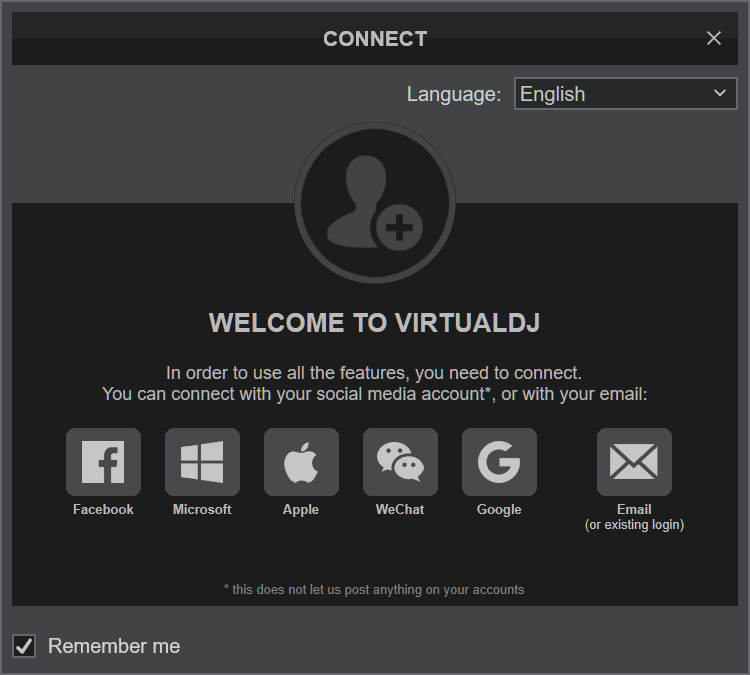
Click on the "Mixon 8 PRO" button in order VirtualDJ to apply the pre-defined audio configuration for your device.
Make sure you have the top-panel Source selectors to USB-A or USB-B depending on the USB port you connected at the rear panel.
Click to OK.

MAPPING
The unit should be visible in the MAPPINGS tab of Config and the “factory default” available/selected from the Mappings drop-down list. The factory default Mapping offers the functions described in this Manual, however those can be adjusted to your needs via VDJ Script actions.
Find more details at VDJ Pedia
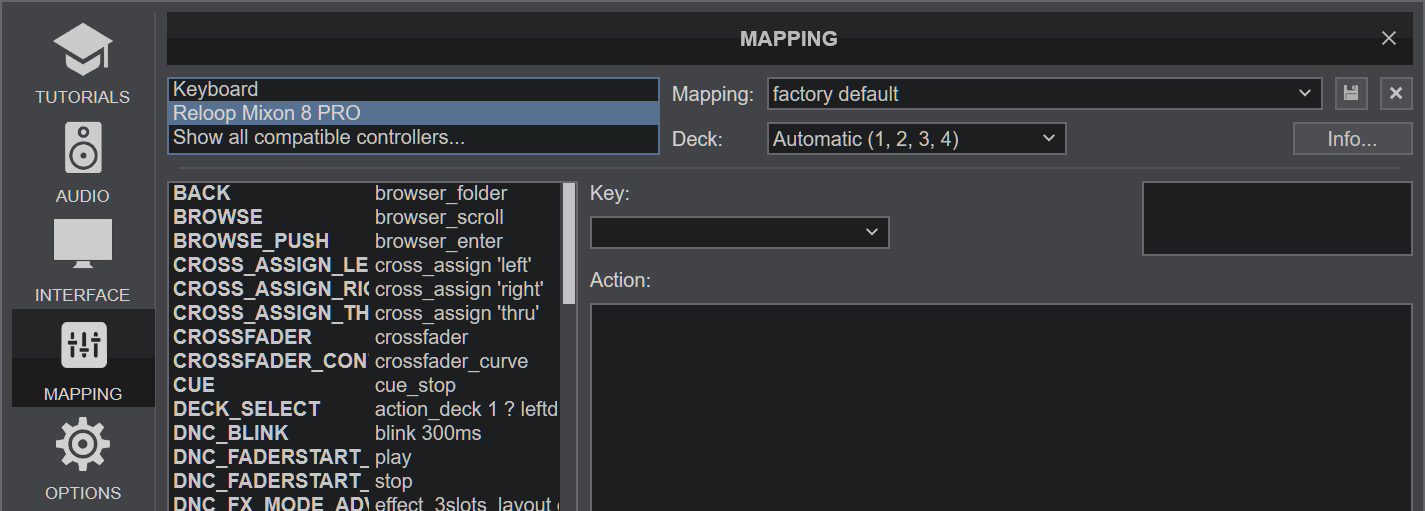
AUDIO Setup
The unit has a pre-defined Audio setup and a special button in the AUDIO tab of Config to provide that.
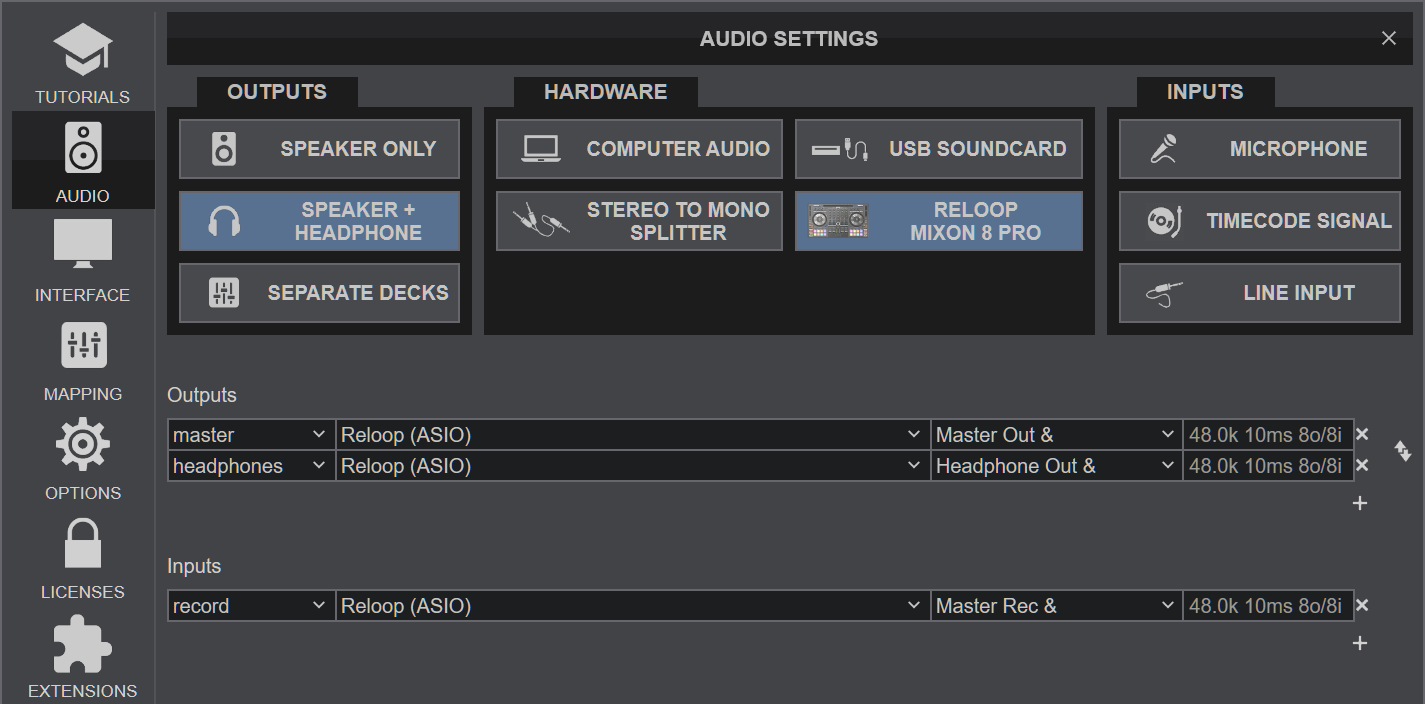
For further software settings please refer to the Manuals of VirtualDJ
LAYOUT

S SHIFT. Hold this button down to access secondary functions of the Reloop Mixon 8 Pro
The functionality of each button and knob per section (as shown in the image below) will be explained in detail in the next chapters
A. Mixer & Browser
B. Deck Controls
C. Effects
D. Pads
E. Front & Rear panels
MIXER & BROWSER
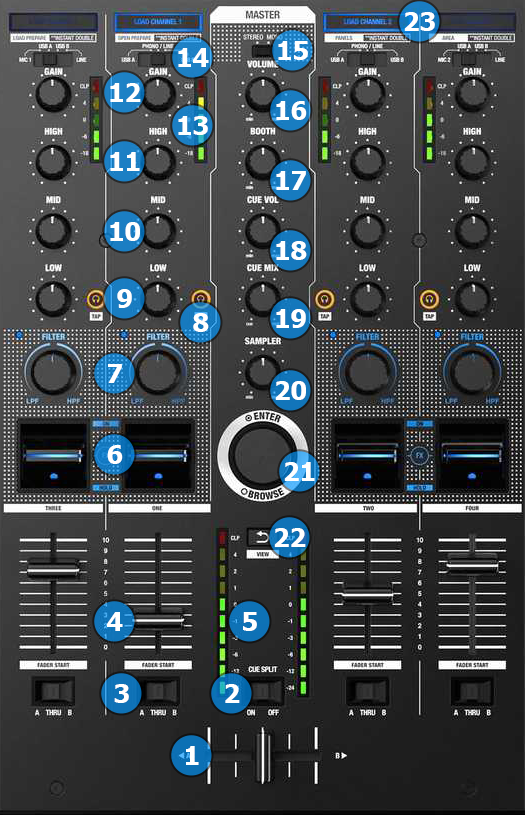
- CROSSFADER. Blends audio between the channels assigned to the left and right side of the crossfader.
- CUE SPLIT. Use this switch to split the audio of the headphones so that the audio of master channel is on the left ear, and the audio of the headphones channel (decks) is on the right ear.
- CF ASSIGN. Set a mixer channel as Left (A position), Right (B position) or Thru. When in THRU position, the crossfader will not affect the output level of the channel. When in A/B position, the output of the channel will be maximum at left/right crossfader position and its output level will be blend with the audio signal of the Right/Left assigned decks depending on the crossfader position and the selected crossfader curve.
- VOLUME. Adjust the Volume of each channel.
Hold SHIFT down and then use use these faders to adjust the Volume of each channel and at the same time stop the deck to the last Cue position, when the fader is at the minimum position and start the deck when the fader moves from the minimum position to any other. (Fader Start/Stop) - MASTER VUMETER. Shows the strength of the Master output's signal.
- FX PADDLES. Use these paddles to activate the selected effect(s).
Move the paddles away from you to activate the selected effect(s) permanently. The paddles will latch to that position.
Pull the paddles towards you to activate the selected effect(s) momentarily. - FILTER. Use this knob to apply a High/Low Pass Filter to the deck. In middle position no filter is applied.
- PFL/CUE. Press these buttons to send the audio signal from a mixer channel to the Headphones Output channel.
- EQ LOW. Adjust the Low (Bass) frequencies for each mixer channel.
- EQ MID. Adjust the Mid frequencies for each mixer channel.
- EQ HIGH. Adjust the High (Treble) frequencies for each mixer channel.
- GAIN. Adjust the Gain of each mixer channel.
- CH VUMETER. Shows the strength of each channel’s pre fader signal.
- SOURCE. Define the source of each channel of the controller.
For PC mixing put the switchers to USB A or USB B position depending on which port you have connected your computer. - STEREO/MONO. Toggle the master output of the controller between stereophonic and monoaural sound (hardware operation).
- MASTER VOLUME. Adjust the level of the Master Output. Hardware operation - movement not visible on the VirtualDJ GUI
- BOOTH VOLUME. Adjust the level of the Booth Output. Hardware operation – movement not visible on the VirtualDJ GUI.
- HEAPHONES VOLUME. Adjust the Volume Output of the Headphones Channel.
- HEADPHONES MIX. Adjust how the Channels and the Master Output blend at the Headphones Channel.
- SAMPLER VOLUME. Adjust the Master Output Volume of the VirtualDJ Sampler
- BROWSE ENC. Scroll through files of folders. Push the encoder to toggle focus between the Folders and the Songs Lists.
Hold SHIFT down and then use the encoder to scroll faster (+/- 15 tracks or folders per click)
Hold SHIFT down and then push the encoder to toggle between the normal and zoomed Browser view - BACK. Use this button to set focus to the Folders List. If focus is already to the Folders List, use this button to open/close sub-folders.
Hold SHIFT down and then use this button to cycle focus between the available Browser windows (Folders, Songs and Sideview). - LOAD. Press these buttons to load the selected track from the Browser to decks 1 to 4. The LED of the button will be on if the deck is loaded.
Hold SHIFT down and then press the LOAD button on Channel 3 to load the selected track to the Automix List.
Hold SHIFT down and then press the LOAD button on Channel 1 to open/close Sideview Browser window.
Hold SHIFT down and then press the LOAD button on Channel 2 to cycle through the available Mixer panels (Audio, Video, Scratch and Master).
Hold SHIFT down and then press the LOAD button on Channel 4 to cycle through the available Sideview windows (Automix, Sidelist, Karaoke, Sampler and Clones).
DECK CONTROLS
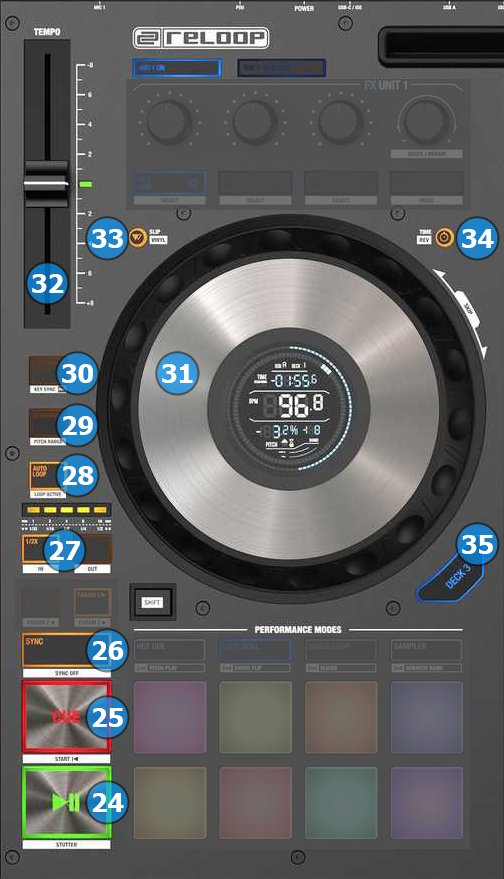
- PLAY/PAUSE. Plays / Pauses the track. Press and hold SHIFT and then press this button to play-sutter the track.
- CUE. When the Deck is paused, you can set a temporary Cue Point by moving the Platter to place the Audio Pointer at the
desired location and then pressing the Cue Button. During playback, you can press the Cue Button to return the track to this Cue Point. (If you did not set a Cue Point, then it will return to the beginning of the track.). If the Deck is paused, you can press and hold the Cue Button to play the track from the Temporary Cue Point. Releasing the Cue Button will return the track to the temporary Cue Point and pause it. To continue playback without returning to the Temporary Cue Point, press and hold the Cue Button, then press and hold the Play Button, and then release both buttons.
Press and hold SHIFT and then press this button to return to the beginning of the track. - SYNC. Press this button to automatically match the corresponding Deck's tempo with the opposite Deck's (or the Master Deck’s if using a 4 decks Skin) tempo and phase.
Hold SHIFT down and then press this button to reset the track's tempo to zero. - LOOP HALF/DOUBLE. Use these buttons to half/double the size of the loop.
If no loop is active, then these buttons adjust the size in beats that's going to be used by automatic loops.
The LEDs above these buttons indicate the selected loop size in beats. When the LED is solid the loop size is designated by the top silkscreen labels. When the LED is flashing, the loop size is designated by the bottom silkscreen labels.
Hold SHIFT down and then use these buttons to set manual loop in and loop out points, for manual looping. - AUTOLOOP. Use this button to enable/disable an auto-loop of the selected size in beats.
Hold SHIFT down and then use this button to enable the last triggered Loop (Re-loop) - SILENT CUE. Press this button to mute the sound of the deck. Press once again or use any of the hotcue pads to restore the sound.
Hold SHIFT down and then use this button to select the next available % range for the Pitch fader. - KEY LOCK. Use this button to lock the key of the track to the current value, and not allow that to change when the Pitch/Tempo is changed (Master Tempo).
Hold SHIFT down and then use this button to match the key of the deck with the one from the opposite deck.
Hold down this key for more than one second to restore the track's key to it's original value. - JOGWHEEL. Touch sensitive platter for scratching (vinyl mode enabled), bending (CD Mode) or Seek mode with built in display. In Vinyl mode, use the jogwheel to scratch and the outer ring to bend.
Hold SHIFT down and then use the jogwheel to navigate through the track (seek mode) - PITCH. Controls the track's playback tempo.
- SLIP. Use this button to enable/disable the Slip mode. When enabled, several functions such as scratching, hotcues and loops will act temporary and when finished, the track will resume playing from the position it would have been if those actions never took place.
Hold SHIFT down and then use this button to enable/disable Vinyl mode. - TIME. Use this button to toggle the display time of the jog display between elapsed and remain modes.
Hold SHIFT down and then use this button to play the track in reverse. - DECK SELECT. Switch Control for the Left decks (1 and 3) and Right Decks (2 and 4).
EFFECTS
The Reloop Mixon 8 PRO offers 2 modes for the Effects control. In the Multi Effect mode, the effect units offer control for 3 Effect slots with 2 effect parameters for each one, while the Single Effect mode offers a single Effect slot but more effect parameters. Use the SHIFT+TAP button to toggle between these 2 modes. Each time a mode is selected, the FX units of the default VirtualDJ skins will display 1 or 3 Effect Slots
On both modes, in order to trigger an effect you must first arm it by using the FX buttons as described below, and then use the FX PADDLES as describes on the mixer section of this manual.
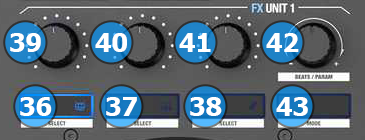
- FX1 ON.
In Multi Effect mode use this button to arm the selected effect of FX Slot 1.
Hold SHIFT down and then use this button to select the next available effect for FX Slot 1.
In Single Effect mode, use this button to arm the selected Effect.
Hold SHIFT down and then use this button to open/close the FX GUI of the selected Effect at the right side of the Browser - FX2 ON.
In Multi Effect mode use this button to arm the selected effect of FX Slot 2.
Hold SHIFT down and then use this button to select the next available effect for FX Slot 2.
In Single Effect mode, use this button to select the previous available Effect.
Hold SHIFT down and then use this button to enable/disable the 1st FX button of the selected Effect (if available) - FX3 ON.
In Multi Effect mode use this button to arm the selected effect of FX Slot 3.
Hold SHIFT down and then use this button to select the next available effect for FX Slot 3.
In Single Effect mode, use this button to select the next available Effect.
Hold SHIFT down and then use this button to enable/disable the 2nd FX button of the selected Effect (if available). - FX1 knob.
In Multi Effect mode the knob controls the 1st parameter of the selected effect of FX Slot 1.
Hold SHIFT down and use this knob to adjust the 2nd parameter of the selected effect of FX Slot 1.
In Single Effect mode the knob controls the 1st parameter of the selected effect.
Hold SHIFT down and then use this knob to control the 4th parameter of the selected Effect (if available) - FX2 knob.
In Multi Effect mode the knob controls the 1st parameter of the selected effect of FX Slot 2.
Hold SHIFT down and use this knob to adjust the 2nd parameter of the selected effect of FX Slot 2.
In Single Effect mode the knob controls the 2nd parameter of the selected effect.
Hold SHIFT down and then use this knob to control the 5th parameter of the selected Effect (if available) - FX3 knob.
In Multi Effect mode the knob controls the 1st parameter of the selected effect of FX Slot 3.
Hold SHIFT down and use this knob to adjust the 2nd parameter of the selected effect of FX Slot 3.
In Single Effect mode the knob controls the 3rd parameter of the selected effect.
Hold SHIFT down and then use this knob to control the 6th parameter of the selected Effect (if available) - BEATS ENC.
Use this encoder to manually adjust the beat-size of beat-aware effects. - TAP/MODE.
Use this button to manually tap the tempo of the track (at least 4 taps while track is playing). When track is paused, use this button to set the current position as first-beat.
Hold SHIFT down and then use this button to toggle between the Single and Multi Effect modes.
PADS
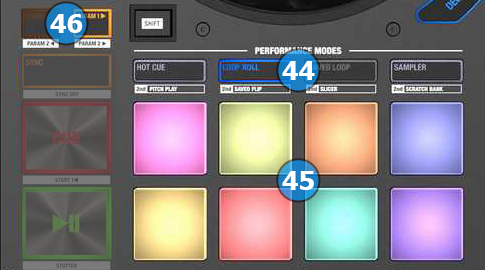
Pads (45) offer 8 different modes, depending on the PAD MODE buttons (44).
Press one of the buttons to select one of the 4 primary modes for Pads (led will light up). When a primary mode is selected, press again the same button to get one of the 4 available secondary modes (led will blink).
Each time a mode is selected, a Page will be selected and displayed on the Pads section of the default VirtualDJ GUI.
You can assign your own pad pages on the PAD MODE buttons, by using VirtualDJ GUI.
The pre-defined primary modes are..
Hotcues, Loop Roll, Saved Loop and Sampler.
The pre-defined secondary modes are..
Keycue, Stems, Slicer and ScratchBank.
Use the PARAMETER -/+ buttons (46) to adjust the Parameter 1 (if available) of the selected Pads page
Hold SHIFT down and then use the PARAMETER -/+ buttons (46) to adjust the Parameter 2 (if available) of the selected Pads page.
FRONT & REAR PANELS

- MIC INPUT. Connect your 1/8” Microphone to this Input.
The Microphone Inputs is not part of the USB audio interface, therefore it can not be added to the Audio setup of VirtualDJ, neither can be controlled by the software or recorded - MIC VOL. Adjust the volume of the Microphone input signal. Hardware operation (not visible on the VirtualDJ GUI).
- HEADPHONES INPUT. Connect a pair of Headphones to this socket (1/4” or 1/8”). The Volume of this Output is controlled by the knob at the top panel
- MASTER OUTPUT BALANCED (XLR): Connect this low-impedance XLR output to a PA system or powered monitors. The level of this output is controlled with the Master knob on the top panel.
- MASTER OUTPUT UNBALANCED (RCA): Use standard RCA cables to connect this output to a speaker or amplifier system. The level of this output is controlled by the Master knob on the top panel.
- BOOTH OUTPUT (TRS): Use standard TRS cables to connect this output to a booth monitoring system. The level of this output is controlled by the Booth knob on the top panel.
- DECK 4 LINE INPUT: Use standard RCA cables to connect analog audio sources such as CD players on the 4th mixing channel of Mixon 8 Pro.
- DECK 2 LINE/PHONO INPUT: Use standard RCA cables to connect analog audio sources such as CD players or Turntables on the 2nd mixing channel of Mixon 8 Pro.
- DECK 2 LINE/PHONO INPUT SWITCH: Set this switch according to the type of analog device that's connected on the deck 2 input.
- GND SCREW: Use this screw to connect the ground terminal(s) of your turntable(s)
- DECK 1 LINE/PHONO INPUT SWITCH: Set this switch according to the type of analog device that's connected on the deck 1 input.
- DECK 1 LINE/PHONO INPUT: Use standard RCA cables to connect analog audio sources such as CD players or Turntables on the 1st mixing channel of Mixon 8 Pro.
- DECK 3 LINE INPUT: Use standard RCA cables to connect analog audio sources such as CD players on the 3rd mixing channel of Mixon 8 Pro.
- USB B. This USB type B connection sends and receives audio and control information from a connected computer.
- USB A. This USB type B connection sends and receives audio and control information from a connected computer.
- USB A SWITCH. Select whether the USB type B port will be used for USB A connection (computer communication) or the USB type C (iOS communication)
- POWER: Use the Power Switch to turn the MIXON 8 PRO on/off. Turn on the unit after all input devices have been connected and before you turn on your amplifiers. Turn off your amplifiers before turning off MIXON 8 PRO.
- PSU. Use the provided AC/DC power supply. While the power is switched off, plug the cable into MIXON 8 PRO first, and then plug the cable into a power outlet.
- MIC INPUT. Connect your microphone. You can use both XLR or 1/4" jack connectors.
